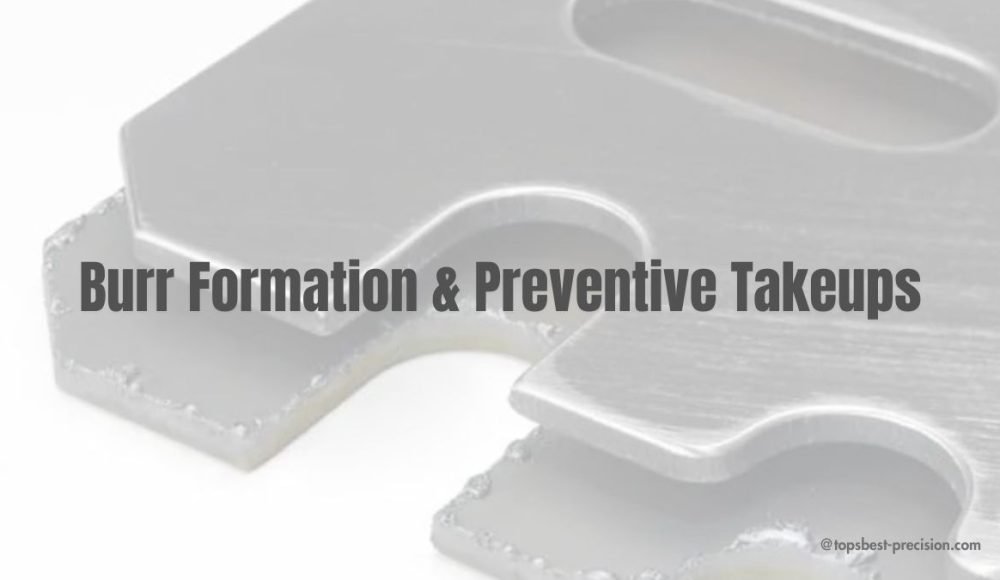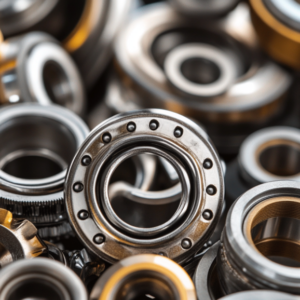Lorsque vous obtenez des services de découpe laser, normalement, vous payez pour un travail de qualité et un excellent service. Cependant, les arêtes vives peuvent être un problème typique. Dans certains cas, la coupe entraîne la formation de bavures, et donc un ébavurage est nécessaire. L'ébavurage a de nombreuses techniques; tout comme les bavures peuvent être créées de nombreuses façons. Donc, Jetons un coup d'oeil aux deux aspects de ce sujet.
Qu'est-ce qu'une bavure?
Une bavure est définie comme une surface rugueuse ou un bord surélevé sur une pièce métallique. Ce problème est le plus fréquemment observé lors de la production, le plus souvent dans la découpe de tôles. Les bavures ont une grande influence sur la qualité et les performances des pièces métalliques. Voici quelques impacts clés des bavures:
- Risques pour la sécurité: Les dangers sont associés aux arêtes vives pour les opérateurs.
- Stress accru: Les bavures peuvent potentiellement entraîner une résistance réduite aux fractures.
- Risque de corrosion: Des épaisseurs de matériau plus épaisses peuvent également entraîner de la corrosion.
- Problèmes de lubrification: Les bavures peuvent également bloquer l'écoulement et gêner le fonctionnement du système de lubrification..
- Problèmes de finition: Ils peuvent poser problème dans des opérations telles que le revêtement en poudre.
La prévention de la formation de bavures est évidente. Cependant, puisque l'ébavurage est souvent le résultat de la fabrication, cela devient indispensable.
Formation de bavures dans les processus de fabrication
Les bavures se développent toujours lors de la fabrication de tôles métalliques à travers de nombreux processus en fonction du type de pièce. Ceux-ci peuvent inclure l'usinage et la découpe.
Les processus d'usinage courants qui laissent des bavures comprennent:
- Fraisage: Fraisage, est un processus identique utilisé en utilisant une sorte de couteaux. Ces couteaux tranchants tournent pour raser le matériau. Donc, risques de bavures qui y sont associées.
- Forage: Laisse des espaces et pourrait même former des arêtes vives.
- Gravure: Gratte la surface, et peut laisser quelques crêtes/rayures.
- Tournant: En tournant, la pièce à usiner tourne autour d'un outil de coupe, ce qui peut entraîner la formation de bavures.
Les processus de coupe utilisés sur la tôle qui entraînent des bavures comprennent:
- Découpe au laser: Coupe les matériaux en utilisant une lumière focalisée.
- Découpe Plasma: Utilise du gaz ionisé pour couper le métal en forme.
- Perforation: Pousse un poinçon à travers le matériau à découper.
- Tonte:Coupe le métal en exerçant uniquement une force de cisaillement.
- Suppression:Coupe et/ou élimine des zones sur la tôle.
En général, toutes les techniques mentionnées ci-dessus ne génèrent pas toujours des bavures. Plusieurs autres facteurs sont connus pour affecter la formation de bavures. En tant que tel, la capacité de l'opérateur et sa conscience du problème peuvent également contribuer grandement à réduire les bavures. De plus, l'épaisseur et la qualité du matériau déterminent la facilité avec laquelle le matériau sera coupé sans formation de bavures. Heureusement, la bande de bavures donne au métal une surface plus lisse car elles peuvent être enlevées.
Types de bavures dans la fabrication contemporaine
La fabrication implique toujours la production de bavures. Des méthodes d’ébavurage appropriées sont donc cruciales. Comme il existe de nombreux types de bavures, il est essentiel de choisir la bonne manière de les éliminer pour obtenir le meilleur résultat.
Fraise de coupure
Une bavure de coupure en saillie implique une projection indésirable d'une pièce à usiner, fréquent lorsque les opérations de découpe manquent leur cible. Le type prévu est souvent observé avec des machines à vis automatiques ou des scies. Pour les processus exigeants en précision, l'ébavurage peut être effectué manuellement pour éliminer les bavures de coupure.
Bavure de déchirure
Plus loin, les bavures de déchirure se produisent lorsque l'action de coupe entraîne plus de déchirure du matériau que de cisaillement. Cela produit généralement une surface irrégulière. L'ébavurage chimique est peut-être, la méthode la plus efficace pour éliminer ces bavures de la surface de la pièce finie. Une technique utilisée dans ce cas dissout les bavures tout en laissant le reste du matériau intact. Donc, dans l'ensemble, cela permet de préserver la qualité du produit.
Fraise de retournement
Parmi ceux-ci, des bavures de retournement se produisent lors du cisaillement, perçant, ou opérations de poinçonnage. Les machines d'ébavurage vibrantes sont utilisées par les fabricants pour éliminer ces bavures. Ces machines sont conçues pour fournir des vibrations mécaniques dans le cadre du processus de retrait.
Bavures chaudes et pointues
Les bavures chaudes sont formées par des cycles irréguliers de chauffage et de refroidissement. Bien que les bavures pointues soient inhérentes aux procédures de fabrication de l'acier inoxydable. Ces deux éléments présentent un danger pour la sécurité dans un environnement d'usine.. Pour éliminer ces bavures de manière optimale, l'ébavurage thermique est encouragé. L'ébavurage thermique s'applique pour contrôler la chaleur afin de brûler les bavures instantanément.
Fraises à retournement
Les fraises de retournement sont également appelées fraises de sortie. Ils se produisent sur les côtés de la pièce à usiner, là où l'outil sort. Ces bavures apparaissent lorsque le matériau est roulé avec l'outil et est forcé sur un rebord.. La taille typique de ces bavures dépend de la profondeur de la coupe d'usinage utilisée pendant le processus..
Fraises à Poisson
Des bavures de Poisson se forment sur le côté de la pièce où la matière s'écoule pendant l'usinage. Spécifiquement, du côté où l'outil entre en premier dans le matériau. La principale raison de leur formation est lorsque le matériau est déplacé perpendiculairement au bord par déformation..
Bavures de déchirure
Les bavures de déchirure se produisent lors de l'arrachement du matériau de la pièce plutôt que lors du cisaillement.. Ce type de bavure est assez typique pour des opérations telles que le poinçonnage lorsque le matériau est éjecté de force.
Éclater / Fraises coupées
Des bavures se produisent souvent lorsque la partie coupée d'une structure se détache du corps principal.. On les trouve généralement dans les coupes de scie et les produits de machines à vis automatiques.. Généralement, entraîne des surfaces rugueuses.
Bavures thermiques
Des brûlures thermiques apparaissent lors des processus thermiques, y compris le soudage, moulage, et découpe laser. Ces bavures sont également identifiées comme des scories ou des éclaboussures. Ils résultent du chauffage puis de la trempe du matériau pour un refroidissement instantané pendant les étapes de production..
Techniques pour un ébavurage efficace
Bien que, la formation de bavures ne peut pas être arrêtée pendant la fabrication. Il existe des moyens, cependant, pour ébavurer les pièces/produits.
Ébavurage chimique
Le processus d'ébavurage chimique élimine uniquement les bavures sur les surfaces métalliques en utilisant des solutions électrolytiques. Le processus est particulièrement vital pour traiter les bavures internes qui sont souvent difficiles à gérer par les techniques conventionnelles.. Les petites bavures sont particulièrement fréquentes sur les surfaces de contact de pièces telles que les corps de pompe et les corps de vanne..
Ébavurage électrolytique
Processus d'ébavurage électrolytique par lequel, par électrolyse, les bavures sont éliminées de la surface métallique. Bien que, ce processus est efficace et peut sans aucun doute éliminer diverses bavures complexes des régions faciles d'accès. Les inconvénients suivants sont associés à l'ébavurage électrolytique.
Inconvénients de l’ébavurage électrolytique
- L'électrolyte est corrosif et peut ternir les surfaces.
- Peut compromettre la stabilité dimensionnelle à proximité de la bavure.
- Nécessite un nettoyage après le processus d'ébavurage.
- Idéal pour les zones difficiles d'accès, comme des cavités.
Autres classifications de bavures
Standardiser la définition des bavures dans diverses industries, cinq classifications ont été établies:
Classe 1: Fraises de petite taille visibles uniquement au microscope.
Classe 2: Fraises à plumes, petites bavures facilement reconnaissables à l'œil nu.
Classe 3: Petit, bavures bien fixées.
Classe 4: Grand, bavures bien fixées.
Classe 5: Fraises extrudées, il ne s'agit pas de vraies bavures mais de déformations du matériau extrudé produites lors du perçage.
Conclusion
Pour améliorer l’efficacité et réduire les coûts, il est important de minimiser le nombre de processus d'élimination des bavures. Ainsi, il est conseillé de travailler avec un fabricant tel que Tops Best qui fournira des produits sans bavure, nettoyer les pièces si possible. Néanmoins, certains matériaux et épaisseurs peuvent créer des bavures au cours du processus. Si vos pièces présentent des bavures à l'intérieur," Le producteur doit également en être informé..
Si les bavures sont inévitables, vous pouvez choisir un processus d'ébavurage parmi celui évoqué plus haut dans cet article. Lorsque vous travaillez avec un lot de pièces, il n'est pas judicieux de passer du temps à les ébavurer manuellement; donc, mettre en œuvre une méthode automatisée. Contactez-nous pour plus d'informations.
FAQ
T1. Que sont les bavures et pourquoi apparaissent-elles?
La bavure est définie comme une surface rugueuse ou une arête vive. Normalement, ils se développent sur une pièce métallique lors d'un processus de fabrication. Ils peuvent survenir lors de la découpe ou de l'usinage ou de toute opération thermique.. La formation de bavures peut avoir un impact significatif sur la sécurité et les performances.
T2. Quelles sont les différentes techniques d'ébavurage?
Certaines des techniques d'ébavurage habituelles sont l'ébavurage manuel., ébavurage à énergie thermique, et ébavurage énergétique chimique. Ils ont tous une efficacité et une pertinence différentes en fonction du type de fraise et du matériau utilisé..
T3. Quelles mesures doivent être prises pour éviter la formation de bavures pendant le processus de fabrication?
Pour minimiser la formation de bavures, il faut choisir des outils et des méthodes de coupe appropriés. Plus loin, de manière optimale, définir les paramètres appropriés de la machine. En plus, le choix des matériaux appropriés et le maintien du niveau approprié d’expérience des opérateurs peuvent contribuer à minimiser le problème de la formation de bavures.
T4. Quels types de matériaux sont les plus sensibles aux bavures?
Le plus souvent, les métaux rigides et certains plastiques développent des bavures lors des opérations d'usinage et de découpe..




1 réfléchi à "Qu'est-ce qu'une bavure & Comment le supprimer?”